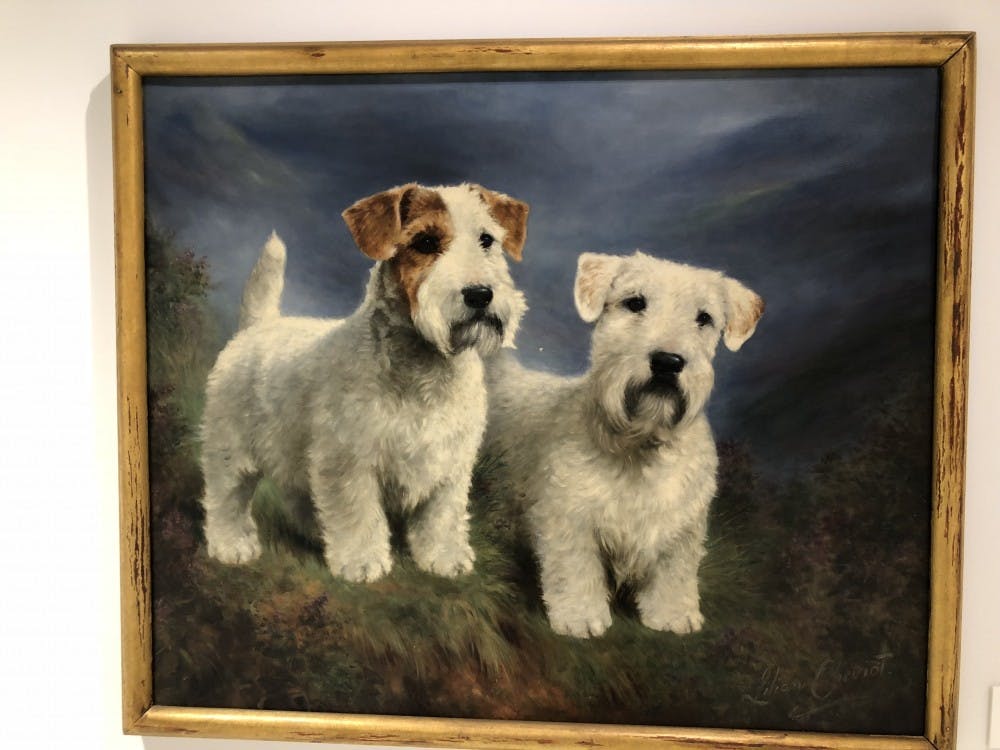If my Instagram feed is any indication, most of you spent spring break soaking up the carcinogenic sun in Cancún, Mexico or Miami. Well I didn’t. An albeit metaphorical ray of sunshine of my vacation, however, was visiting the American Kennel Club (AKC) Museum of the Dog in Manhattan.
The museum was originally located in New York City between 1982 and 1986, boasting one of the largest collections of dog art in the world. After three decades in St. Louis, it moved to the AKC’s headquarters on Park Avenue in February.
The collection features 200 bronze and glass figurines, paintings, and sculptures, as well as a library containing over 42,000 books about man’s best friend (patriarchally speaking). I would’ve gotten a kick out of describing the museum as all bark and no bite, but such a characterization would be far from the truth.
Some highlights include a giant wire dog sculpture, a terracotta paw print from the Roman Empire dating back two millennia, large canvases by Queen Victoria’s favorite painter Sir Edwin Landseer, Alfredo Garcia Aguilar’s vibrant abstract art and the remains of Belgrave Joe — a 19th-century canine from whom descend several breeds of fox terriers. I also adored heartwarming paintings of dachshund puppies and Airedale terriers, as well as William Wegman’s photographs of Weimaraners.
The oldest piece in the museum is a 30-million-year-old fossil of the Hesperocyon, an ancient dog-like mammal, from modern-day Nebraska. The newest? An interactive game where you can train a digital puppy, a “Meet the Breeds” touch screen where you can examine the histories and features of the AKC’s 193 recognized breeds, and a “Find Your Match” kiosk that matches visitors’ facial features to a dog breed. I apparently resemble a Boston terrier; to my disappointment, a whopping 87 percent of my Instagram followers (at least those who voted in the poll on my story) agreed with this soul-crushing assessment.
My similarity to the Boston terrier is not skin-deep. Indeed, the Boston terrier is a non-sporting breed. Upon further research, I’ve discovered that, in 1893, the Boston terrier was the first American breed to be recognized by the AKC. In fact, the Boston terrier was the first non-sporting breed to originate in the U.S.
The notion of dog breeds in general is fairly new, according to journalist Allison C. Meier, who reviewed the museum for Curbed.
“While there were different types of dogs before the Victorian era, there was little consideration of their aesthetics. They were kept as pets for functional and companionship purposes, but eventually, certain types became fashionable, too,” she wrote. “The first modern dog show dates to 1859 in [...] England, where sporting dogs were judged on appearance rather than skills. The formation of organizations like the Kennel Club in the UK in 1873 led to the centralization of specifications of breeds.”
Founded about a decade later, the AKC is a registry of purebred dog pedigrees in the U.S. The New York Times reported in 2013 that animal protection services, law enforcement agencies and lawmakers have discovered that “the club is lax in performing inspections and that it often lobbies against basic animal rights bills because they could cut into dog registration fees.” This rubs my fur the wrong way. And as Chicago ABC7 noted last week, “some animal-welfare groups feel the pursuit of purebred dogs puts their looks ahead of their health and diverts people from adopting pets.”
Critics believe that the AKC must do more to combat puppy mills. The “ongoing routine kennel inspection program” it describes on its website isn’t enough. New York Times reporters Mary Pilon and Susanne Craig recounted one harrowing example of this from 2011: a raid of a kennel of AKC-registered litters in Montana.
“Officials found 161 severely malnourished malamutes living off their own feces in small cages... Many of the dogs had diseases; one had advanced cancerous growths,” they wrote. “Dead dogs were stacked outside small kennels.”
According to Chicago ABC7, AKC says it “encourages responsible breeding of healthy dogs, not as a beauty contest but to preserve traits that have helped dogs do particular jobs.” But AKC dogs, because of inbreeding in the name of purity, often have genetic disorders. The dog shows it sanctions seem eerily like toxic beauty pageants.
The AKC Museum of the Dog was no doubt an aesthetic masterpiece, but I’m feeling the same feeling I have when I eat at Chick-fil-A. ThinkProgress found mere days ago that, in 2017, Chick-fil-A donated more than $1.8 million to groups with a history of anti-LGBTQ discrimination, “despite reportedly claiming it was winding down that practice.” I’m gay, but I find Chick-fil-A delicious. How can I reconcile those two positions? Why would I want to line the pockets of my would-be oppressors?
Two weeks ago, The News-Letter Voices columnist Alex Walinskas asked, “When learning that people like R. Kelly have committed sexual assault or are otherwise morally flawed, should we still celebrate their creative successes?” As a dog lover, should I feel guilty about supporting the often harmful AKC by attending its albeit aesthetically pleasing museum?
To be honest, I don’t know how to overcome this cognitive dissonance. But it is something we should think about whenever we consume art.





